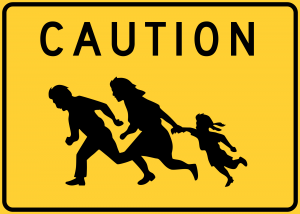Yesterday, in the Rose Cafe, GRF Esmeralda Arrizon-Palomera talked on the subject of undocumented youth in the United States, particularly in Southern California. Being from Atlanta, on the complete opposite side of the US, I’d never heard about something called the Dream Act or even seen the road sign that’s apparently quite common in SoCal that “cautions” drivers about families crossing the border. I was, and still am, aware that the topic of illegal residents is a very hot, very controversial one in our nation today, but I had no idea that there are currently up to 6 million undocumented individuals living in the U.S. And I had no idea that their experience is what it is. Esmerelda spoke on how certain policies, such as the Dream Act and DACA (or Deferred Action for Childhood Arrivals) have been formed to help these undocumented youth, but that over time, such policies have actually come to harm some of these individuals. By that, she meant that even certain propaganda–such as posters depicting a youth in a cap and gown–don’t encompass every undocumented child or adolescent in the country. There are other individuals who may not want to go to school, or who don’t want to, or who are content with working in the labor force; what about them? Where’s the legislative backing for those individuals? If they don’t qualify for the Dream Act, what happens to them? Why is this group of people not being depicted on posters or being supported by President Obama?
I mean, granted, the president has done a lot for this demographic (maybe not all that he could’ve, but nonetheless, he’s done made strides), and that’s something that can’t be said for everybody, and specifically can’t be said for every candidate currently running for president. I hate to get political, but listening to this talk prompted me to think about the men and woman running for the title of the President of the United States and what exactly he or she plans to do to help the fight for rights of Latinos–and all minorities, for that matter. At one point, Esmerelda said that many of these undocumented youth have paralleled their experiences to the African-American struggle/experience, and the Civil Rights Movement. An example of such a comparison was La Gran Marcha, which took place in May of 2006 in protest of a bill that was in the making, which would have effectively made being an illegal resident a felony and would’ve made offering assistance to an undocumented individual a crime. Because of the solidarity of Latinos that was shown during this event, the bill was struck down; “If people can come together to do something so great,” Esmerelda concluded, “what more can be done to bring down discrimination and establish actual human rights for Latinos and African-Americans in the United States?” And how much easier would this be if our next president won’t just fight for the rights of privileged white males (or females), but also for the rights of EVERYONE–male, female, Black, White, Asian, Hispanic, Native-American, queer, straight, young, old, rich, and poor. A girl can dream right?




